|
December 3, 2022
Dear Neighbors and Friends,
I hope that you and your loved ones are doing well, staying healthy, and looking out for your neighbors and friends during this past week.
If you’re getting this week’s newsletter first thing Saturday morning, it’s not too late to sign up for this morning’s virtual constituent coffee, which starts at 9:00! You can register here.
This week is “Legislative Days” at the Capitol, where many of the issues to be addressed in the upcoming session will be previewed. For your convenience I’ve put together a detailed list of all the hearings and topics, with links to the presentations and committee bills that will be introduced. You’ll find that right after this intro. Please let me know if you have any questions about the schedule or need assistance in navigating the Oregon Legislative Information System (OLIS).
On the COVID front we’re continuing to see big increases in COVID hospitalizations and infections, exacerbated by the surge in RSV cases among very young children and the beginning of flu season. Wastewater analysis is also continuing to showing more increases than decreases in our cities. The Portland metro area is showing a big increase in COVID test positivity.
As you’ll see in the links, Multnomah County’s health officer is now recommending that people voluntarily wear masks when in indoor public place in order to help contain the spread in the metro area.
We have a new report and forecast from OHSU that suggests that we are approaching the peak of both the COVID surge and the RSV surge here in Oregon. We can expect a very gradual decline beginning in a couple of weeks. You’ll find details below.
Until next week, please do your best to stay happy, healthy and safe. And let me know if you have any questions or thoughts about anything in this week’s newsletter.
DECEMBER LEGISLATIVE COMMITTEE AGENDAS
During this coming week the Legislature will hold a series of remote committee hearings for the last of our so-called “Interim Leg Days” prior to the 2023 session that begins in January and continues until June 25.
Below is a list of the agenda items scheduled for this week, with links to the committee webpages that include the actual agendas and other materials. The pages will also let you know who will be testifying on each of the agenda items.
Nearly all of the committees will be voting on the introduction of committee bills for the upcoming session that starts in January. You can find the text of those legislative concepts (LCs) by clicking on the “Meeting Materials” tab on each committee agenda page. (Many are already posted; the rest should be posted a day or two before the hearing.) In addition, many of the committees will also be hearing about relevant legislative concept proposals coming from individual members.
The "Meeting Materials" tab will also get you to reports, PowerPoints, and other information related to the topics in the hearings. You can of course watch the hearings live or later in recorded form.
For the most part, these meetings are not public hearings, so there won’t be an opportunity for public testimony at this time (though you can of course always contact committee members directly with your input). There will be opportunity for written and oral/video testimony on bills during the February session itself.
For the first time since February 2020, committee meetings will be in person at the Capitol, though many of those providing invited testimony will do so via Microsoft Teams.
If you'd prefer, here's a PDF version of the committee and task force list, times, and topics.
Wednesday, December 7
Senate Judiciary and Ballot Measure 110 Implementation, 8:30-11:00 a.m.
- Ballot Measure 114
- Oregon State Bar (OSB) Update
- Aid and Assist Update
- Public Defense Services Work Group
- Jail Health Care Standards Advisory Committee Report
- SB 575 Juvenile Expungement Update and Upcoming Legislation
- Introduction of Committee Bills
Senate Labor and Business, 8:30-11:00 a.m.
- Introduction of Committee Bills
House Economic Development and Small Business, 8:30-11:00 a.m.
- Semiconductor Industry Opportunities
- Rural Economic Development
- Oregon Cultural Activities Update
- Impact of Sports Events on Small and Rural Communities
- Understanding Oregon’s Tax Structure
- Introduction of Committee Bills
House Housing, 8:30-11:00 a.m.
- Oregon Housing and Community Services 2023 Legislative Agenda
- Eviction Data and Housing Stabilization
- Oregon Housing Needs Analysis Implementation
- Joint Task Force on Addressing Racial Disparities in Home Ownership
- 2023 Session member Legislative Concepts
- Sector Work Group Concepts, Rep Marsh
- Urban Reserve Workforce Housing, Rep Morgan
- Public-Supported Affordable Housing, Rep Neron
- Minimum Lot Size, Rep Hieb
- Introduction of Committee Bills
House Business and Labor, 11:30 a.m. to 2:00 p.m.
- Wage Theft in the Construction Industry
- Wage Theft Enforcement
- Update on Future Ready Oregon (SB 1545, 2022)
- Update on Data Privacy Work Group
- Introduction of Committee Bills
Early Childhood, 11:30 a.m. to 2:00 p.m.
- Early Childhood Vision for the State
- Introduction of Committee Bills
- Discussion of Personal Bills
Emergency Board Subcommittee on Education, 11:30 a.m. to 2:00 p.m.
- Higher Education Coordinating Commission - Oregon National Guard State Tuition Assistance
- Teacher Standards and Practices Commission - Equity Centered Principals Pipeline
- Department of State Lands - South Slough Capacity Building
- Department of Fish and Wildlife - Culvert Projects with ODOT
- Department of Fish and Wildlife - Wildlife Disease Detection and the Aquatic Habitat Conservation Plan
- Department of Forestry - 2022 Fire Season
- Department of Forestry - Forest Restoration Byproduct Commercialization
- Department of Land Conservation and Development - Coastal Zone Management Capacity Building
- Department of Land Conservation and Development - Cape Foulweather Land Acquisition
Emergency Board Subcommittee on Human Services, 11:30 a.m. to 2:00 p.m.
- Various Consent Grants and Individual Appropriation Items
Senate Rules and Executive Appointments, 2:30-5:00 p.m.
- Executive Appointments
- Introduction of Committee Bills
House Agriculture, Land Use, and Water. 2:30-5:00 p.m.
- Integrated Water Resources Strategy Update
- Water Recycling in Oregon
- Willamette Water Supply System
- Climate-Friendly and Equitable Communities Rulemaking
- Introduction of Committee Bills
House Health Care, 2:30-5:00 p.m.
- Interim Reproductive Health Workgroup
- Joint Task Force on Universal Health Care
- Joint Task Force on the Bridge Health Care Program
- HB 4003 (2022) Nurse Workforce Report
- Discussion and Introduction of Committee Bills
Joint Gambling Regulation, 2:30-5:00 p.m.
- Introduction of New Oregon Racing Commission Executive Director, Connie Winn
- Overview of County Fair Horse Racing, Continued
- Presentation and Discussion of Draft Interim Committee Report
Emergency Board Subcommittee on General Government, 2:30-5:00 p.m.
- Consent Reports
- Individual Items
Thursday, December 8
Senate Energy and Environment, Senate Energy and Environment, 8:30-11:00 a.m.:
- Introduction of Committee Bills
- Department of Energy Biennial Energy Report
- Small-Scale and Community-Based Renewable Energy Projects Study
- Truth in Labeling Task Force Report
- Embodied Carbon of Building Materials
- Introduction to Member Concepts
Senate Health Care, 8:30-11:00 a.m.
- Health System Costs: Financial Trends and Impact on Oregonians
- Financial Assistance and Charity Care
- Prescription Drug Price Transparency Report
- Joint Task Force on Universal Health Care
- Discussion of Committee Member Health Care Concepts
- Introduction of Committee Bills
House Environment and Natural Resources, 8:30-11:00 a.m.
- Introduction of Committee Bills
- Committee Member Presentation of Concepts
- Wildfire Habitat Concervation and Management Program Overview
- Renewable Hydrogen in Oregon: Overview and Opportunities
- Renewable Energy Siting Issues and Opportunities
- Biennial Energy Report Overview
- Wildfire Policy Advancements
Joint Legislative Audits, 8:30-11:00 a.m.
- Public Defense Services Commission Internal Auditor Functions Budget Note Report
- OHA Prescription Drug Monitoring Program follow-up report (Report 2022-17) - Secretary of State Audits Division
Senate Natural Resources and Wildfire Recovery, 11:30 a.m. to 2:00 p.m.
- Oregon Wildfire Programs Update – SB 762 (2021)
- Oregon Aquaculture Act Overview
- Introduction of Committee Bills
House Human Services, 11:30a.m. to 2:00 p.m.
- Preview of Concepts
- Reducing Child Poverty
- HB 2544 (2021) Update
- HB 2102 (2021) Update
- HB 2333 (2021) Update
- Introduction of Committee Bills
House Revenue, 11:30 a.m. to 2:00 p.m.
- Introduction of Committee Bills
- Property Tax Discussion – Part 3 of 3 (Exemption Policies)
- Annual Property Tax Statistics
- Tax Expenditure Report
- Exemption Policy Overview
- Policies Scheduled to Sunset
- Administrative Issues
- Data for the Legislative Revenue Office/Legislature
House Veterans and Emergency Preparedness, 11:30 a.m. to 2:00 p.m.
- Oregon Military Department Status and State of Readiness
- Portland Air National Guard Update
- The Oregon Civil Air Patrol
- Gold Star Families Memorial Highway Legislation Introduction
- Oregon Seismic Safety Policy Advisory Commission (OSSPAC) Overview
- Oregon State Fire Marshal Agency Transition and Fire Season Summary
- Emergency Management and Seismic Implications of Portland Area Bridges
- Introduction of Committee Bills
Senate Education, 2:30-5:00 p.m.
- Summer Learning Programs
- Digital SAT
- Educator Workforce Shortages
- National Center on Higher Education Management System (NCHEMS) Report on Higher Education Landscape in Oregon
- Introduction of Committee Bills
Senate Finance and Revenue, 2:30-5:00 p.m.
- Tax Credit Report for 2023
- Property Tax Exemptions Report for 2023
Senate Housing and Development, 2:30-5:00 p.m.
- Affordable Housing Production
- Workforce Housing Production
- Eviction Date, Tenant and Housing Provider Impacts
- Houselessness: Current Landscape and Policy Consideration
- 2023 Session Member Legislative Concepts
- Senator Steiner: Child Care in Residential Dwellings
House Behavioral Health, 2:30-5:00 p.m.
- Introduction of Committee Bills
- Oregon State Hospital Update
- Mosman Decision and Impacts on the Community
- Increasing SRTF and RTF Capacity
- HB 2949 Implementation Update
- HB 5202 Implementation Update
House Rules, 2:30-5:00 p.m.
- Secretary of State Legislative Agenda
- Election Debrief
- Automatic Voter Registration
- Racial and Ethnic Impact Statement Pilot Exercise
- Member Concepts for 2023 Session
- Introduction of Committee Bills
Friday, December 9
Senate Human Services, 8:15-11:00 a.m.
- The Benefits Barrier: Stipends for Benefits Eligible Participants and State Boards and Commissions
- Introduction to New Director of Oregon Department of Human Services Office of Developmental Disabilities Services
- Paying Parents of Minor Children for Attendant Care Services: An Overview of Legislative Concepts
- Kids Mental Health Package Overview
- Overview of member legislative concepts
- Introduction of Committee Bills
Veterans and Emergency Preparedness, 8:30-11:00 a.m.
- Introduction of Committee Bills
- Purple Star Schools
- Occupational Licensure for Military Spouses or Domestic Partners
- State Income Tax Exemption for Military Pay Received by Oregon National Guard Service Member on State Active Duty
- State Active Duty Pay Rate Development and Summary of Recent State Active Duty Missions
- State Active Duty Command and Control Structure
- My Health VA Portal
- Emergency Management – Tribal Perspective
House Education, 8:30-11:00 a.m.
- Update on HB 2864 (2017) Cultural Competency Mandate
- Update on Joint Task Force on Student Success for Underrepresented Students in Higher Education \Update on Enrollments at Public Institutions of Higher Education
- Comprehensive Update on 3rd Grade Elementary Literacy
- Introduction of Committee Bills
Joint Transportation, 8:30-11:00 a.m.
- Introduction of Committee Bills
- Improving Safety on Oregon’s Roadways
- County Safety Corridor Pilot Program Report (HB 3213, 2019)
- Update on ODOT Safety Programs and Powell Blvd.
- Safely Navigating Roadways in Dark and Rainy Conditions
- Briefing on Tolling and Congestion Pricing
House Judiciary, 11:30 a.m. to 2:00 p.m.
- Introduction of Committee Bills
- Oregon State Bar (OSB) Update
- Public Defense Services
- Introduction of OPDS Director
- Criminal Justice Commission Update
- Public Safety Measures
- Consumer Privacy Task Force Legislative Concept Introduction
- Discussion of Committee Member Legislative Concepts
Joint Emergency Board, 12:30-3:00 p.m.
- Consent Grants
- Consent Reports
- Individual Items
Joint Information Management and Technology, 1:00-2:15 p.m.
- Oregon Broadband Office and Broadband Grant Programs
- IIJA State and Local Cybersecurity Grant Program
- Introduction of Legislative Concept LC 966, Relating to Cybersecurity
Wildfire Recovery, 2:30-5:00 p.m.
- Interim Committee Work Group Summaries
- Disaster Recovery Authority Work Group
- Firefighter Capacity Work Group
- Agency Updates on Wildfire Recovery Implementation
- Wildfire Recovery Housing Expenditures
- Septic System Repair and Replacement Grant Program
- Reflections on 2020 Wildfire Recovery
And here again is the calendar for all of the committee meetings this week:
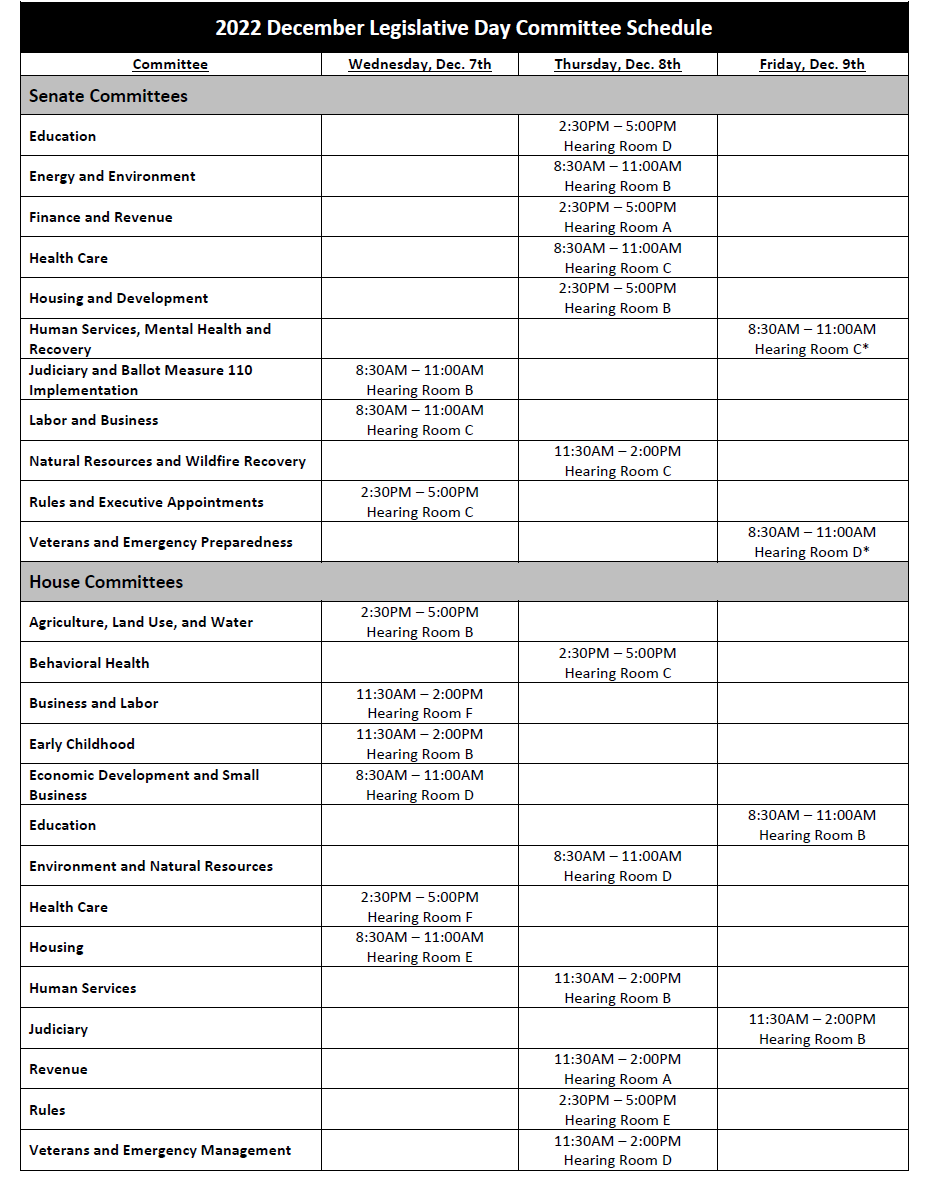 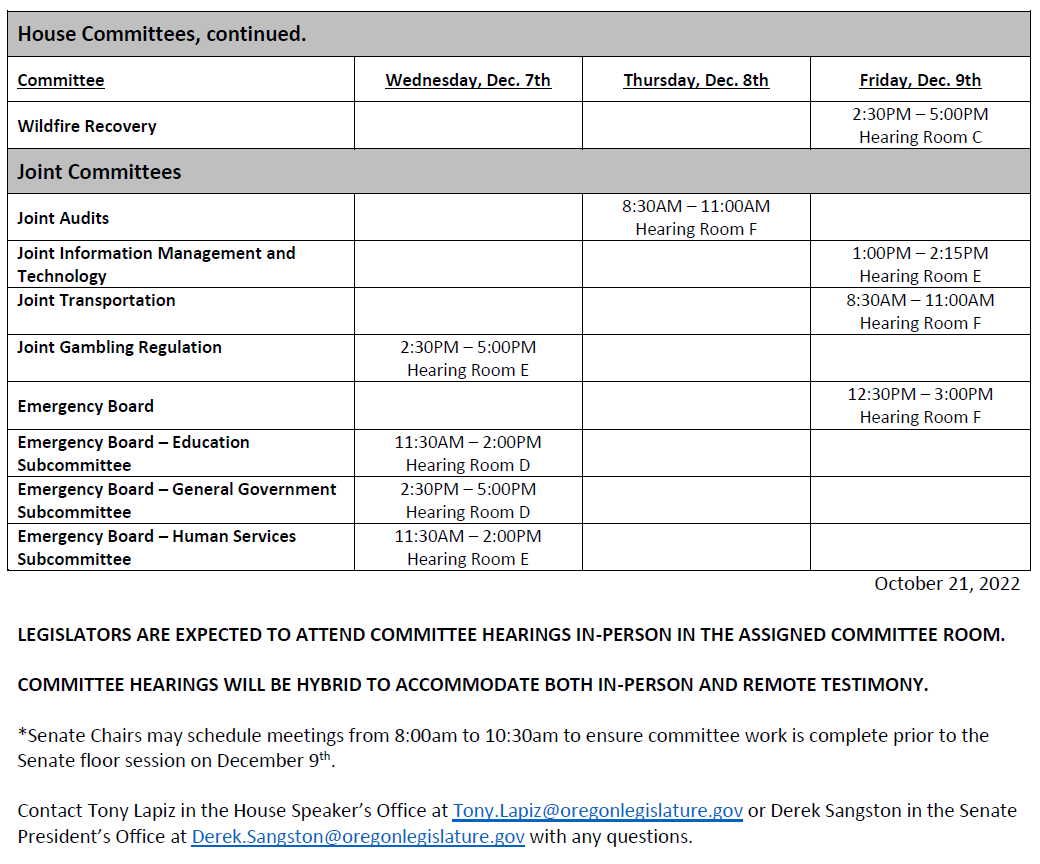
ON THE COVID FRONT
Weekly Data Report:
OHA now updates and reports COVID metrics once a week, on Wednesdays.
Here are the last set of daily results, for this past week from 11/24/22 through 11/30/22.
As you’ll see, this week’s report is a mixed one.
- The 7-day average for new infections declined somewhat last week, from 512 the previous week to 475 reported infections per day this last week. The number of new cases is again likely an undercount, as many people are using home tests to determine their infection status but are not reporting those results.
- Average test positivity for the last week increased substantially, to 9.6% vs. the previous week’s 7.2%. Again, this number skews high because it likely reflects a higher proportion of people showing COVID symptoms (and thus reporting or going in for a test, rather than self-testing and never reporting).
- On Wednesday there were 363 COVID-19-related hospitalizations statewide, increasing from 311 last Wednesday. Hospitalizations are now our best indicator of disease spread. Again, however, most of these hospitalizations are not in and of themselves due to COVID—more than half are those who tested positive after having been admitted for other reasons.
- The number of COVID patients in Oregon’s ICUs on Wednesday went back down a little from 45 to 38. These are the most serious COVID infections.
- There were 40 COVID-19-related deaths reported during the last week, up from the previous week’s 37. Again, some of every week’s reported deaths actually occurred in earlier weeks but were just reported to the state. The newsletter’s final graph shows when the deaths actually occurred, and you’ll see that the number of COVID deaths each day continues to remain low.
Weekly County Report: Some Counties Again High Risk
The CDC assigns risk levels based on a combination of the number of new COVID cases and the number of people in hospital for COVID.
According to the CDC Daily Counter (updated each Thursday), after 8 weeks without any counties being at High Risk of COVID infection, this week three are, all in the northeast corner of the state: Baker, Union, and Wallowa.
Five rural Oregon counties (the same as last week) have reported infection rates that place them in the Medium Risk category, all of them in South and Southeast Oregon: Jackson, Josephine, Klamath, Lake, and Malheur.
The remaining 28 Oregon counties (down from 31 last week) are at Low Risk.
We can also track the cases, deaths, and test positivity rates for each county at this website.
The three Portland-area counties showed substantial increases in positivity rates from the previous week. Clackamas County is 11.0%, up from last week’s 8.0%. Multnomah County jumped to 10.3%, up from last week’s 6.8%. Washington County is the region’s highest this week, up to 11.3% from last week’s 7.1%.
Remember, though, that these are all based on reported test results, and so are more likely to be a little higher than the total percent positivity (i.e., if one were to include all tests taken).
This Week’s Wastewater Monitoring Report: More Increases
With testing reports giving us just a fraction of infections out there, wastewater monitoring has become a more reliable indicator of the amount of virus in cities around the state. That report is updated each week.
This week’s report is largely the same as last week. It again does show more increases, but it also shows more decreases. Eighteen percent of the cities showed an increase or sustained increase last week (up from 15%). Nine percent of cities (down from 3%) showed decreased or sustained decrease in viral load from the previous week. Seventy-three percent of the cities tested (down from 79% last week) again showed no change.
Portland, McMinnville, Corvallis, Bend, and Siletz were again the locations showing sustained increases last week.
OHSU Forecast Again Shows Increases in COVID and RSV
Another OHSU Forecast Report, was released on Friday. It uses data provided by OHA and others that project how fast the virus may spread in the population and provides projections on possible outcomes, including infection rates and impacts on hospital capacity. The lead author is Dr. Peter Graven, Director of OHSU’s Office of Advanced Analytics.
This week’s forecast is similar to the last one. It continues to show continued increases in hospital demand over the next couple of weeks, followed by gradual declines.
Here are some details:
- As of Nov. 30, 363 people were in the hospital with COVID. That's a sharp increase from 230 on Nov. 16.
- More people in Oregon have entered the hospital with flu in the same period. Nationally, the flu peak may be lower than in average flu seasons.
- Statewide, the number of available beds is 260. This is the lowest number since January 6, 2022.
- The number of people in the hospital with RSV remains at record levels in Oregon.
- Oregon should be at or near a peak for RSV. The number of RSV cases declined slightly last week but is expected to bounce back to its peak this week, and then should flatten and begin to decline in a few weeks.
- The amount of boarding, or patients in the ED waiting to find a bed for admission to the hospital, is at its highest levels.
- COVID cases are expected to peak at 408 on Dec. 12. But new variants seem to be driving up cases nationally.
- The levels remain low compared to previous waves.
- Wastewater data show a slight uptick in COVID infections in Oregon and the nation.
- People with COVID symptoms make up 5.5% of emergency department visits, an increase.
- The percentage of people testing positive for COVID has increased from 7.2% two weeks earlier to 10.6% .
- As of Nov. 30, 6% of the patients in Oregon's ICU beds had COVID.
- As of Dec. 1, five children were in the hospital with COVID. That’s the same number as two weeks ago.
- RSV cases are expected to remain significant over the next three weeks.
- The BA.5 variant is causing fewer COVID cases, 42%. New variants could drive more infections and hospitalizations.
- The number of COVID deaths is forecasted to remain relatively flat.
OHA Changing or Merging Some Services
The Oregon Health Authority has just reported that they are transitioning COVID-19 services and data tracking to align with the current phase of the pandemic. Temporary pandemic response resources are closing or being integrated into existing health care systems.
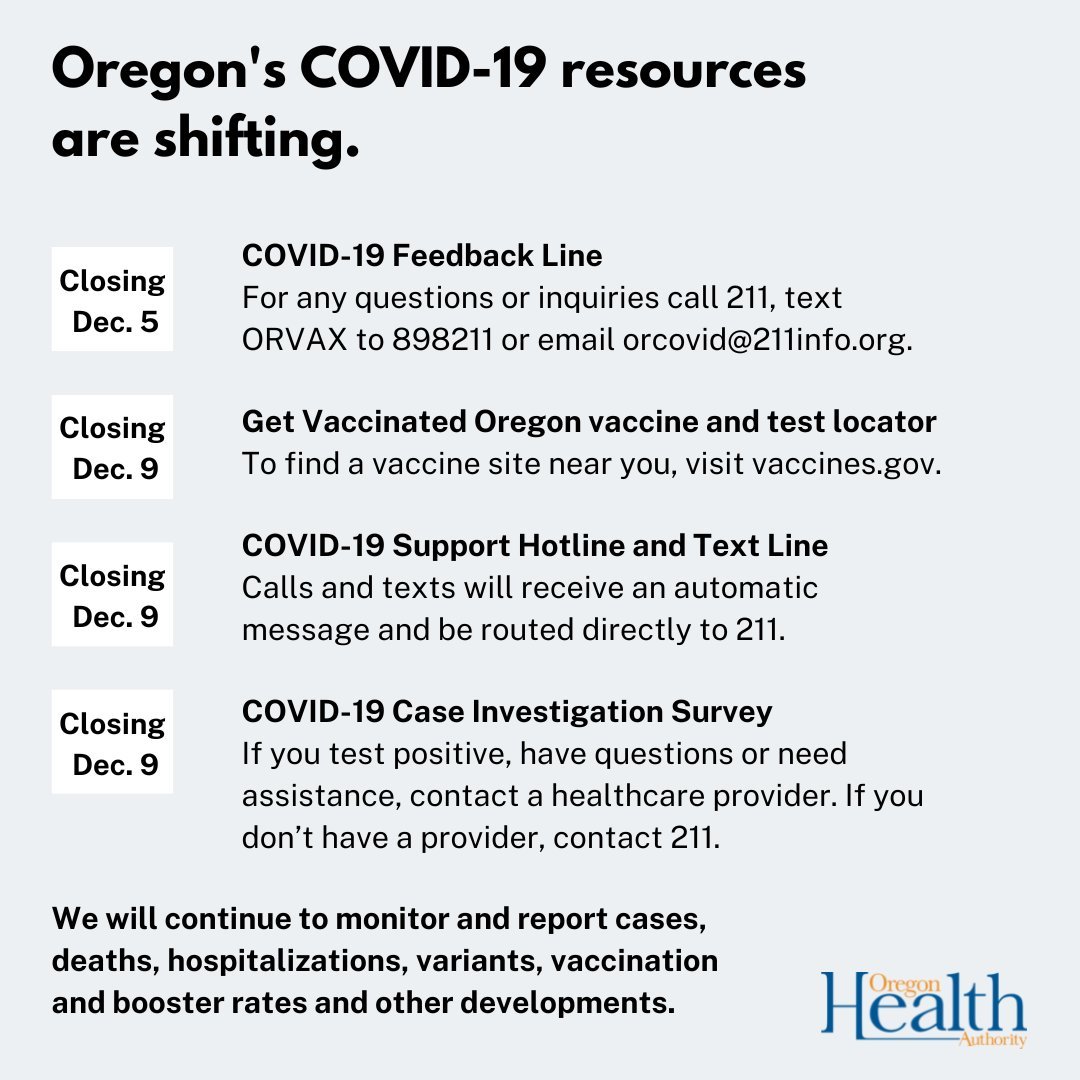
COVID Q & A from OHA’s Dr. Cieslak (from OHA weekly newsletter)
Dr. Paul Cieslak, OHA senior health advisor and medical director, Communicable Diseases and Immunizations, answered this week’s questions.
Q: I am up to date with all my COVID-19 shots and boosters and still wear a mask in crowded situations. A friend of mine refuses all vaccinations, claiming that, "People with vaccines are the ones who pass it on to others because they don't show symptoms." Is there any validity to her claims? – Sylvia, Portland
A: “No. There is no evidence whatsoever that vaccinated people are more likely to transmit COVID-19 than unvaccinated people. Anyone, vaccinated or not, can be infected with COVID-19 and not experience symptoms. And anyone, vaccinated or not, can spread COVID-19 even if they’re not experiencing symptoms.”
Q: I tested positive for COVID-19 with two different tests. Can I get Paxlovid? I am 73 years old. – Gary, Sisters
A: “COVID-19 antivirals such as Paxlovid are recommended for adults who are at high risk of severe disease, to reduce the risk of hospitalization or death. Age can be a factor in determining eligibility. You should seek treatment as soon as you test positive, and treatment should start within five days of symptom onset.
To find Paxlovid, first talk to your medical provider. If you do not have a medical provider, here are two other options:
The Test-to-Treat (T2T) program connects people in person to medical professionals who can prescribe COVID-19 antivirals. Check here to see if there is a T2T location near you. If you don’t have insurance, you may be charged a fee.
If you have access to the internet, go online to Color Health Inc. and start a free telehealth service that can connect you virtually to a medical professional who can prescribe COVID-19 antivirals within an hour. If you do not have access to the internet, call 833-273-6330.”
Q: If I'm fully vaccinated and exposed to someone with COVID-19 who is not vaccinated (showing no symptoms at the time of my exposure), is that person more of a risk to me than someone with COVID-19 who is vaccinated? In other words, is the virus in an unvaccinated person more contagious than the virus in a vaccinated person? – Melanie, Salem
A: “When people get COVID-19 despite having been vaccinated, they can shed virus in amounts approximately equal to those shed by unvaccinated infected people. You could get COVID-19 from either a vaccinated or unvaccinated person, and I don’t think we can say that one poses more risk than the other.”
Additional COVID Updates and Links


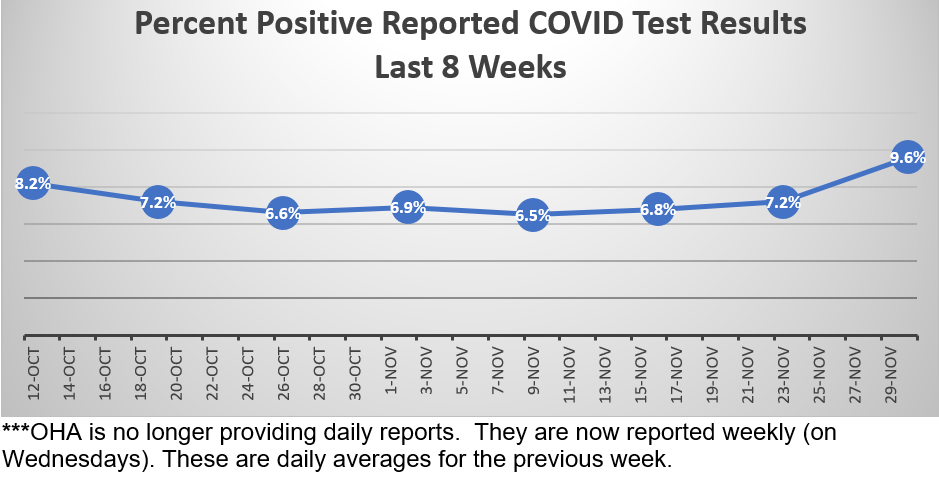

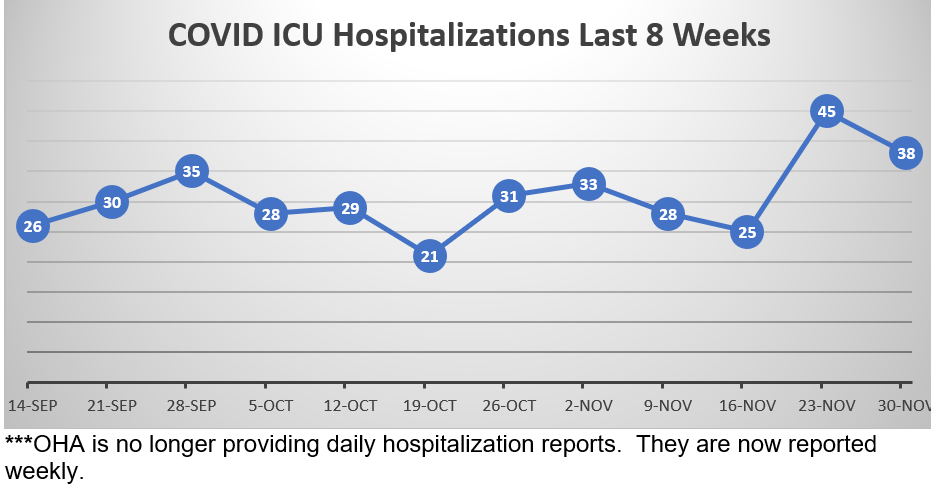



Here again are some COVID resources that you will find useful:
If the above links are not providing you with answers to your questions or directing you to the help that you need, please consider me and my office to be a resource. We’ll do our best to assist you or steer you in the right direction.
Want to See Past Newsletters?
If there was COVID-related information in a past newsletter that you want to go back to, but find you’ve deleted it, you can always go to my legislative website (senatordembrow.com), click on “News and Information,” and you’ll find them all there. Also, if someone forwarded you this newsletter and you’d like to get it directly, you can sign up for it there.
Best,
 Senator Michael Dembrow
District 23
email: Sen.MichaelDembrow@oregonlegislature.gov
web: www.senatordembrow.com
phone: 503-281-0608
mail: 900 Court St NE, S-407, Salem, OR, 97301
|